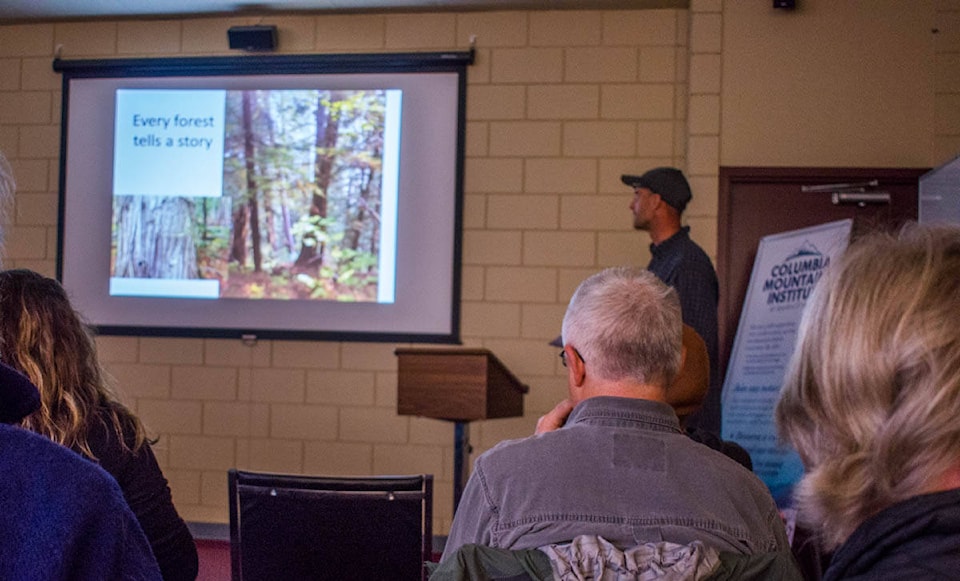Yesterday was the season’s first CRED Talk which focused on different logging practices.
The Revelstoke Community Forest Corporation presented on other methods for harvesting trees, as opposed or in addition to clear cutting.
“Every forest tells a story,” says Kevin Bollefer, professional forester at the Revelstoke Community Forest Corporation.
Bollefer says much can be learned about a forest simply by walking through it and observing.
For example, if trees are growing crooked in a particular area that may be due to unstable ground. And so, it would be better not to log because it could cause a landslide.
“You look around to see what’s causing what,” says Bollefer.
The Revelstoke Community Forest Corporation was formed in 1993 to manage and operate Tree Farm License (TFL) 56. It’s owned by the City of Revelstoke and all profit goes back to the city. TFL 56 is located an hour north of Revelstoke in the Downie Creek and Goldstream River drainage. It covers an area of 120,000 hectares of which roughly half is forested. According to the company’s website, while some of the timber in the area is of very high quality, much is full of rot and decay and suitable only for pulpwood. And so, one challenge for the company is maximizing its returns.
READ MORE: CRED Talks kick off for another season
One possibility, may be through thinning. For this scenario, the company harvests or cuts some trees in a block, leaving behind trees of higher value, such as red cedar, to grow larger and become more valuable.
“It’s not all about volume, but also value,” says Bollefer.
For example, one cedar pole may be worth $37, but if it’s left for another 40 years, it may be worth $1,200.
Thinning a forest can allow more light, which not only helps trees but can provide more ground vegetation, which can be more desirable for wildlife.
Bollefer says thinning or partial cuts can improve biodiversity. While clear cutting can be a faster way to grow trees and produce more lumber overall, the quality and value of the timber may not be as high.
“In my perspective, you need both clear cutting and partial cuts,” says Bollefer.
“We don’t need to have clear cuts everywhere.”
At the moment, Bollefer says the Revelstoke Community Forest Corporation thins 10 to 15 per cent of their area. Eventually, he would like that number to raise to 30 per cent. Maybe even beyond.
With partial cutting or thinning poor quality timber can be removed, such as hemlock, which is not as desirable as red cedar.
“Cedar is our money tree,” says Bollefer.
According to the B.C. government, cedar 2x4 monthly average this year $1,405 US/000 bd ft as compared to SPF 2x4 lumber, which is a combination of spruce, pine, and fir, at $546 US/000 bd ft.
Thinning can also remove the trees that will soon die. For example, older fir trees are more susceptable to insects and pine to blister rust.
“We can immitate what’s happening naturally in the forest and harvest before the trees dies,” says Bollefer.
The harvested trees can help pay for thinning and the trees left behind, would in theory become more valuable for harvesting later.
“In my mind, it’s a win-win,” says Bollefer.
Of course, sometimes things don’t go to plan.
“You can walk through an area ten years later and there aren’t as many trees as there should be,” says Bollefer.
Perhaps the area is too dry, windy, or wet. Or for whatever reason, the trees just aren’t growing.
“Sometimes it just doesn’t work.”
READ MORE: Revelstoke Community Forest Corporation creates legacy fund for city
CRED Talks are organized by the Columbia Mountains Institute of Applied Ecology. CRED stands for Columbia Region Ecological Discussions and the event is sponsored by Revelstoke Credit Union. This is the third season of the talks. The next CREDtalk is scheduled Dec. 12. Check the Columbia Mountains Institute of Applied Ecology for more information and details on upcoming presentations: http://cmiae.org/event/cred-talks-columbia-region-ecological-discussions/
@pointypeak701
liam.harrap@revelstokereview.com
Like us on Facebook and follow us on Twitter.
